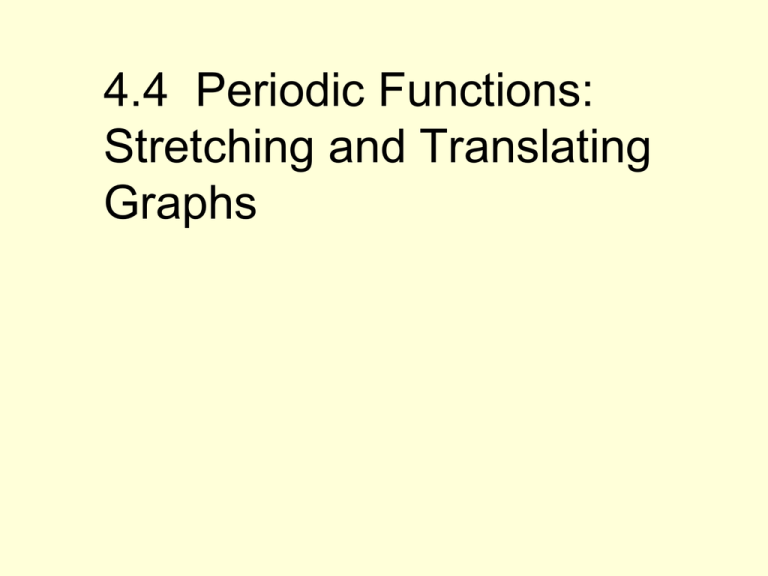4.4 Periodic Functions: Stretching and Translating Graphs
advertisement

4.4 Periodic Functions: Stretching and Translating Graphs The world is full of periodic phenomena. The tides come in and go out again and again, each cycle or period lasting about 12.4 h. The amount of daylight increases and decreases with a period of one year. The functions that describe periodic behavior are called periodic functions. You have Pre-Calc class every 24 hours. Periodic functions A function f is periodic if there is a positive number p, called a period of f, such that f x p f x for all x in the domain of f. Meaning that the “height” of the function f remains the same at the points which one period apart. In the definition of “periodic function”, please note the wording: -- “if there is a positive number p”, meaning the value of the period is not unique. It could be some other values. -- “such that … for all x in the domain of f ” the equality f x p f x must be true for ALL x values in the domain of f , NOT just some of the x values in the domain of f . -- If x – p is still in the domain of the function f , then f x p f x f x p To a periodic function, any multiple of the period p is a period to this function. For example, 2p, 3p, 4p,…, np (n N), are the period of this periodic function. Because f x f x p f ( x p) p f x (2 p ) f ( x 2 p) p f x (3 p) f x (np) The definition implies that if f is a periodic function with period p , then f x f x np for all x and any integer n. The smallest period of a periodic function is called the fundamental period of the function. (Fundamental period is unique!) Example 1 The graph of a periodic function f is shown below. Find a) The fundamental period of f; b) f (99) [Answer] a) The fundamental period of f is p = 4; b) Note that 99 ÷ 4 = 24 R 3 f (99) = f (3 + 24·4) = f (3) = –2 Or, f (99) = f (99 – 24·4) = f (3) = –2 If a periodic function has a maximum value M and a minimum value m, then the amplitude , denoted as A, of a periodic function is defined as one half of the distance between its maximum and minimum function value. It is always positive. M m A 2 Example 2 Find the amplitude of the function f described in Example 1. 2 2 A 2 2 Periodic Functions • Lets look at the Sin Graph (in radians): Period 2 Amplitude 1 Stretching and Shrinking Graphs • The graph of y = c f (x) where c is positive (and not equal to 1) is obtained by vertically stretching or shrinking the graph of y = f (x). The points on the x-axis remain fixed, • while all other points move away from the x-axis for c > 1 (a vertical stretch) or • while all other points move toward the x-axis for 0 < c < 1 (a vertical shrink). • The period of y = c f (x) remains the same ( p ) • The amplitude of y = c f (x) becomes cA. • Examine graphs p. 140 Stretching and Shrinking Graphs Vertical Stretching and Shrinking Graphs The graph of y = c f (x) Stretching and Shrinking Graphs • The graphs shown on p. 140 are all based on a periodic function f with fundamental period 4 and amplitude 2. Notice that a vertical stretching or shrinking of the graph of f affects the amplitude but not the period. • The graphs shown on previous slide are all based on a periodic function f with fundamental period of 2 and amplitude 1. Notice that a vertical stretching or shrinking of the graph of f affects the amplitude but not the period. Stretching and Shrinking Graphs • The graph of y = f (cx) where c is positive (and not equal to 1) is obtained by horizontally stretching or shrinking the graph of y = f (x). The points on the y-axis remain fixed • while all other points move toward the y-axis for c > 1 (a horizontal shrink) or • while all other points move away from the y-axis for 0 < c < 1 (a horizontal stretch). • For c > 1, the periodic function y = f (cx) has shorter (smaller) period; for 0 < c < 1, the periodic function y = f (cx) has longer (larger) period. • The period of y = f (cx) becomes p/c ; • The amplitude of y = f (cx) remains the same ( A ). • Examine graphs p. 140 Horizontal Stretching and Shrinking Graphs Horizontal Stretching and Shrinking Graphs The graph of y = f (cx) y = sin(2x) Frequency is doubled, period is halved. y = sin(1/2x) Frequency is halved, period is double Stretching and Shrinking Graphs The graph of y = f (cx) y = sin(3x) Frequency is tripled, period is 1/3. Horizontal Stretching and Shrinking Graphs • The graphs shown on p. 140 are all based on a periodic function f with fundamental period 4 and amplitude 2. Notice that a horizontal stretching or shrinking of the graph of f affects the period but not the amplitude. • The graphs shown on previous slides are all based on a periodic function f with fundamental period of 2 and amplitude 1. Notice that a horizontal stretching or shrinking of the graph of f affects the period but not the amplitude. Changing the Period and Amplitude of a Periodic Function • If a periodic function f has period p and amplitude A, then: • y = c f (x) has period p and amplitude cA, and • y = f (cx) has period p/c and amplitude A. Translating Graphs • We have already learned in Algebra 2 that the graph of y = f (x – h) + k is obtained by translating the graph of y = f (x) horizontally h units and vertically k units. • So, the graph of y – k = f (x – h) is obtained by translating the graph of y = f (x) horizontally h units and vertically k units. • Examine graphs p. 141 Translating Graphs If the equation y = f (x) is changed to: y = – f (x) y = | f (x) | y = f (–x) x = f (y) y = cf (x), y = cf (x), y = f (cx), y = f (cx), c>1 0<c<1 c>1 0<c<1 y – k = f (x – h) Then the graph of y = f (x) is: Reflected in the x-axis Unchanged when f (x) 0 and reflected in the x-axis when f (x) < 0 Reflected in the y-axis Reflected in the line y = x Stretched vertically Shrunk vertically Shrunk horizontally Stretched horizontally Translated h units horizontally and k units vertically More Examples • Tell whether g appears to be periodic. If so, give its fundamental period and its amplitude, and then find g (1000) and g (–1000). Assume that g (1) = 21/2, g (2) = –21/2. p = 3, g (1000) = g(1 + 3333) = g (1) = 21/2. g (–1000) = g(2 – 3343) = g (2) Or = – 21/2. This function is an odd function. So g (–1000) = – g (1000) = – 21/2. More Examples Use the graph of y = f (x), to sketch the graph of the following. a. y = 2 f (x) b. y = f (1/2x) c. y = –1/2 f (x) d. y = f (–2x) e. y = f (x –1/2) f. y = f (–x) + 1 Assignment P. 136 #2, 8, 10, 14, 16, 21, 27, 29, 31 P. 143 #1 – 5, 7, 9











